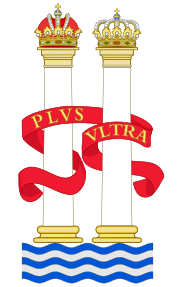Pillars of Heracles
As Pillars of Hercules ( ancient Greek αἱ Ἡράκλειοι στῆλαι hai Herakleioi stelai ) were referred to in ancient times two rock mountains, the Strait of Gibraltar (Latin Gaditanum Fretum border): the Rock of Gibraltar ( lat. Calpe) south of the Iberian Peninsula and the mountain Jebel Musa in Morocco, west of the Spanish exclave of Ceuta . Other sources refer to Abyle (Latin mons Abila ) directly from the Spanish Ceuta in North Africa , which is now known as Monte Hacho , as the southern pillar of Heracles.
According to the Greek poet Pindar , Heracles put the inscription “No further” at the exit of the Mediterranean Sea to mark the end of the world . The Latin version of this saying is non plus ultra . After the discovery of America and the accession of Charles V , it was changed to Plus Ultra and thus found its way into the Spanish coat of arms as a motto.
history
The Phoenicians reached and crossed the strait on their voyages of discovery no later than 900 BC. BC, which is proven by early Phoenician finds in Huelva , which are dated to the late 10th or early 9th century. They named the two promontories that border the Mediterranean Sea as the pillars of Melkart ( Baal of Tire ) after their sun god . The name of the god was later equated with the Greek Herakles by the Greeks per Interpretatio Graeca . They further stated that this strait was the end of the world and was once set by Heracles when he passed Tartessus on his way to steal the herd of cattle from Geryon .
However, the mention of these columns in the Germania of Tacitus , who suspected them to be in the area of the Frisians , contradicts this early view . Plato settled his mythical island kingdom of Atlantis on the other side of the pillars of Heracles, as the known part of the world ended here for the ancient Greeks.
coat of arms

The columns of Heracles appear in the coats of arms of Spain , Andalusia , Melillas and the city of Cádiz . If they are next to the actual coat of arms , they are counted among the " gems " in heraldry ; within the escutcheon , pillars are a so-called " common figure ". The crowning of the columns in the Spanish coat of arms are different: heraldically on the right (i.e. left when viewed from the front) the crown of Charles III. , heraldic left the Spanish royal crown. In the coats of arms of the first and second Spanish republic , the columns were not crowned.
symbolism
The motif of the pillars of Heracles found widespread use in different contexts. The Renaissance philosopher Francis Bacon used it z. B. in his Instauratio magna as a symbol for consciously breaking through the knowledge boundaries of antiquity and the Middle Ages. ("Many will drive through it and the knowledge of science will increase" is the signature of the title graphic.)
Pictures on site
The Spanish coast near Tarifa with the Djebel Musa in the background
literature
- Heinz-Günther Nesselrath : The pillars of Heracles - a mythical landmark and its meaning in classical antiquity. In: Yearbook of the Academy of Sciences in Göttingen 2008, de Gruyter, Berlin / New York 2009, ISBN 978-3-11-022160-2 , pp. 226–232.
- Meyers Großes Konversations-Lexikon , Volume 17, Leipzig 1909, p. 640. Digitized
Web links
supporting documents
-
↑ The first evidence can be found in the Greek poet Pindar , who in his third Olympic song about a victory for Theron of Akragas in the chariot race at the Olympic Games of 476 BC. Chr. Writes:
"Εἰ δ ἀριστεύει μὲν ὕδωρ, κτεάνων δὲ χρυσὸς αἰδοιέστατος, νῦν δὲ πρὸς ἐσχατιὰν Θήρων ἀρεταῖσιν ἱκάνων ἅπτεται οἴκοθεν Ἡρακλέος σταλᾶν. τὸ πόρσω δ᾽ ἔστι σοφοῖς ἄβατον κἀσόφοις. οὔ νιν διώξω: κεινὸς εἴην. "
“But as true as water is the best, gold is worthy of all goods: So now Theron touches, reaches the limits, Heracles' pillars through virtues of his race. A higher goal is denied to wise men and fools. I do not pursue it, I would be truly vain. "
- ↑ Fernando González de Canales Cerisola: Tarshish-Tartessos, the Emporium Reached by Kolaios of Samos. CIPOA 2, 2014, pp. 559f. - online version
- ↑ 10. Herakles' task in the library of Apollodorus , Greek & German
- ↑ Cornelius Tacitus , Germany and its Tribes, 34 Alfred John Church, William Jackson Brodribb, Ed








